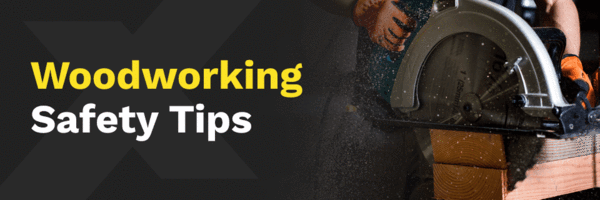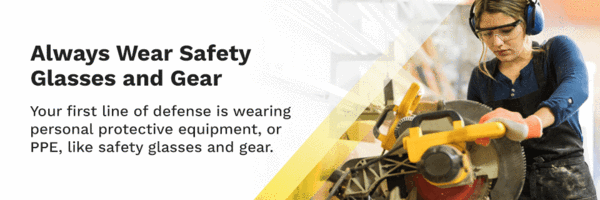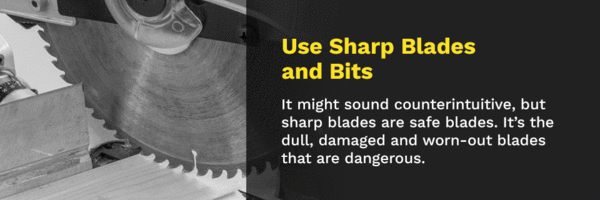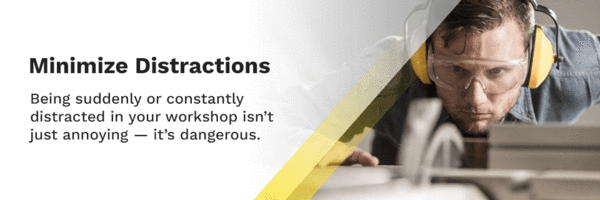
Woodworking safety is a serious issue. Regardless whether you’re a novice woodworker or a seasoned professional, being safe while turning out projects is a primary concern. Safety is also a vital issue for others working around you. By working together and watching out for each other, everyone in a woodworking shop can be safe and enjoy their job.
There are always dangers present in a woodworking environment, including sharp blades and bits, as well as aggressive power tools. Being in a shop also exposes you to environmental hazards like glues, paints and sawdust particles. You’re always at risk for electrical shock or getting cut by hand tools. And then there’s the danger of having loose clothing or hanging jewelry caught in moving machines.
Despite the safety risks in a woodworking shop, there are also the rewards. Woodworking is a great hobby or occupation when you’re aware of your surroundings and know your hazards. Working safely also includes being familiar with your materials and equipment. Following basic safety rules results in hours of enjoyment, and that makes working safely so rewarding.
Your workshop is no place for carelessness or ignoring the safety rules, though. The key to being safe in a woodworking shop is awareness and compliance. Safety requires more than due diligence. It takes a commitment to be safe every time you enter your shop and start handling your tools. Part of your commitment is continual learning about safety procedures. For that, we’ve brought you these woodworking safety tips.
Always Wear Safety Glasses and Gear

It’d be nearly impossible to do woodworking projects without your eyesight. It’d also be hard to work without your fingers and toes. Every part of your body has some sort of risk in a woodworking shop. Your first line of defense is wearing personal protective equipment, or PPE, like safety glasses and gear.
Your standard woodworking PPE must include safety eyewear. That can be safety glasses with side shields or even a full face mask in the right conditions. Make sure your eyewear meets OSHA standards, though. Inferior eye protection is a bad investment.
Your PPE kit should include hearing and respiratory protection. Ear protection ranges from earplugs to earmuffs. You should use respirators appropriate to your task. That might be a disposable dust mask when cutting lumber or a HEPA-filtered unit when working with toxic fumes.
Wear Appropriate Clothing
Appropriate clothing is also part of your personal protection kit. Your woodworking dress code should make it mandatory that what you’re wearing in the shop doesn’t present a danger on its own. Loose and baggy clothes are the worst offenders when it comes to getting snagged and tangled in moving equipment.
You’ll always want a balance of something comfortable and non-restrictive while not being overly hot and irritating. Long-sleeved shirts and full-length pants are safer than shorts and T-shirts. Safety clothing also extends to wearing gloves in the right conditions and always having appropriate footwear.
Avoid Wearing Jewelry
Woodworking shops aren’t the place for hanging chains or dangling pendants. They’re so vulnerable to catching in revolving blades or spinning belts. Having a neck chain or lanyard caught in a mandrel can be a life-threatening disaster.
If you do have a special piece of jewelry, make sure to keep it protected from tools. Tuck chains and lanyards out of sight. You’ll also want to assess if that watch you’re wearing or ring on your finger is hazardous in your shop. If you have the slightest doubt, take it off and pocket it.
Disconnect Power When Changing Blades or Bits
Servicing on any power tool or equipment piece that’s still energized is downright dangerous. You should always consider a plugged-in tool as a running tool. Every tool that’s energized is just waiting to expend its power, and you’re especially vulnerable when changing blades or bits.
Make sure you don’t just shut your tool off by the switch when switching bits or blades. Either unplug your tool’s primary cord or shut off the breaker at the power source. You can also lock out the power to be extra careful. But no matter how you do it, ensure you have completely de-energized your tool before servicing it.
Don’t Use Drugs or Alcohol
This tip should go without saying. However, it’s amazing how impaired people lose their judgment and decide to pick up a woodworking project. That’s a dangerous decision, and it could result in serious injuries.
Drinking alcohol before or while woodworking is foolish. So is consuming recreational drugs like marijuana, since they alter your state of mind. Then, there are legitimate prescription pills, like painkillers and anti-depressants, to avoid. No matter what impairment substance, do not mix it with woodworking.
Use Sharp Blades and Bits

It might sound counterintuitive, but sharp blades are safe blades. It’s the dull, damaged and worn-out blades that are dangerous. Sharp blades cut your wood fast and leave clean edges with few splinters to impale you. They also have less kickback, which is a hazardous part of woodworking.
The same goes for sharp drill bits. They don’t jam and bind like dull bits do. Buying high-quality saw blades and bits has a high return on investment. So does sending your blades and bits to a professional sharpening. Don’t let your cutting tools go dull at any time.
Check Wood for Nails
Reclaimed wood is a highly sought-after commodity. There’s something about the look and feel of aged wood people love. But, for the woodworker, there can be something highly dangerous lurking inside old wood: nails from the original woodworkers.
Make sure you always check wood for nails or other fasteners before you start using it. Visual inspections are fine, and you can probably catch embedded nails from telltale holes. However, your best bet if you handle a lot of reclaimed wood is getting a metal detector. Regardless of your system, make sure you catch old nails before they ruin your saw blades or cause you an injury.
Work Against the Cutter
Almost every experienced woodworker knows to work against the cutter. That means to bring your work to the cutting tool whenever possible. It’s safer to feed work against a stationary blade, rather than forcing it onto the work surface. Working against the cutter reduces the chance of dangerous kickback.
However, many novice woodworkers and occasional hobbyists don’t know this important safety tip. That’s because they’ve never learned to work against the cutter. It’s not something that seems natural and obvious. So the next time you’re in your shop, make sure to work against your cutting tools.
Use a Single Extension Cord
How often have you seen someone using power tools strung together with multiple extension cords? You’ve likely noticed they’re suffering a current drop, not mentioning presenting a safety hazard with a tangle of intertwined cords. They also tend to interrupt work when one or more connections pop loose.
Make it a standard practice to always use a single extension cord when using power tools at a distance longer than their attached cord allows. Also, make sure you’re using a heavy enough cord to supply ample current at a distance. Your tools will thank you for it by not struggling for power. You’ll do safer and more accurate work as well without the risk of having multiple saws or power tools having power.
Never Reach Over a Running Blade
Reaching over a running blade is one of the most dangerous things you can do in your woodworking shop. The chance of you slipping and engaging the blade is far too high. Many woodworkers have become seriously or permanently injured by accidental contact while reaching across a running blade.
Instead, take the time and effort to reach around a running blade if you need to get behind it. Better yet, if something is that important, shut your tool off and stop the blade. And, never forget how essential blade guards are. Make sure they’re always in place.
Minimize Distractions

Being suddenly or constantly distracted in your workshop isn’t just annoying — it’s dangerous. Distractions take your eyes and mind off what you’re doing and set them elsewhere. That can leave your hands and fingers exposed and vulnerable.
Distractions come in many forms. Usually, it’s someone unexpectedly entering your shop unannounced. It can also be outside sources like a radio program or vehicle noise. One of the most distracting things in today’s workshops is a cell phone. To avoid a dangerous distraction, leave your phone in a different room.
Ask for Help When You Need It
This workshop tip could save you from serious harm. When you’re working with a heavy or bulky piece, don’t try to hero it along. There’s no shame in asking for help. It’s unsafe to try to complete tasks that are beyond your physical limitations. You could suffer from serious injuries, such as accidental contact with a running blade or muscle strain causing a back pain. You can avoid this by just asking for help when it’s needed.
Never Work When You’re Tired
Being tired is another form of impairment. Tiredness limits your attention span, as well as your powers of observation. Fatigue and drowsiness impair your judgment and slow your thought processes almost as much as alcohol and drug use.
If you’re feeling tired or sluggish, please give a second thought about going to work in your shop. Ask yourself if it’s really necessary to do your task right then. Perhaps it’s best to have a nap or even put your project off until you’ve had a good night’s sleep.
Clamp Workpieces Down Firmly
Loose and insecure woodwork materials can be dangerous. You can lose control of your piece and send it flying from the saw table or workbench. That becomes a missile in the shop and leaves anyone in the line of fire vulnerable to getting hurt.
Always clamp workpieces down firmly. For small pieces, your hand pressure might be sufficient. But, for big components, make sure you use a mechanical restraint. There are so many clamp forms available, and they let you get creative.
Take Time to Read the Tool Manual Before Using a New Tool
You know what they say about reading the instructions, right? Think about the last time you went through the manual after buying or adopting a new tool. Did you thoroughly read it and absorb what it said?
Manufacturers go to a lot of trouble to produce owner manuals. They do it because they want you to get full benefits from your purchase. They also produce manuals because they want you working safely. Take time to read the manual before using a new tool. There’s a lot of safety information in there.
Clean Up Sawdust
A clean shop is a safe shop, while a dirty and cluttered shop is a dangerous place. Keeping a clean woodworking shop is the hallmark of a good woodsmith.
Sawdust is an inevitable byproduct in woodworking shops. But, it doesn’t have to lie about and create a safety hazard. You can slip on it, breathe it in and let the stuff block your vision. This won’t happen if you always clean up sawdust.
Keep the Blade Cover on Saws Whenever Possible
Most bladed power tools come with manufacturer-supplied covers. They’re there for a reason, and that’s to keep you safe. Keeping blade covers on lets them do their job.
If you have to remove a blade cover, make sure you do it safely. De-energize your tool, and keep your blade cover off only as long as necessary. Then, replace your cover before returning to work.
Do Not Try to Free a Stalled Blade Until the Power Is Off
If you do a lot of woodworking, you’re going to experience stalled blades. Actually, beginners are more prone to stalling blades than the old-timers. That’s because the woodworking vets know how to avoid blade stalls.
Something else longtime woodworkers know is never to try freeing a stalled blade until the power is off. That’s a cardinal rule. Energized tools can unexpectedly start and badly hurt you. Make sure your tool has no energy supply when you free a stalled blade.
Use Push Sticks or Pads When Using a Table Saw, Jointer, Bandsaw, Router Table or Sharpener
Push sticks and pads are finger and hand savers when you’re using a table saw, bandsaw, router table or sharpener. Getting your fingers too close to spinning blades, bands and wheels is dangerous. It’s also unnecessary.
Commit yourself to woodworking shop safety, and always use a push pad or stick when making close contact with a cutting tool. These aids don’t need to be fancy or expensive, but they are necessary.
Use Well-Maintained Tools

Maintaining your tools is another sign of a good woodworker. You’ve got a lot invested in your tool collection, and you want to protect it. Routine tool maintenance is part of the process.
You’ll have a lot of benefits from using well-maintained tools. Besides lasting longer and performing better than worn equipment, well-maintained tools are safer. Part of your woodworking plan is safety. Well-maintained tools help you achieve that.
Take a Training Course
Woodworking is like any other creative activity: The more you do of it, the better you’ll get. There’s another side to this thinking, too. The more you know about woodworking, the safer you’ll be.
You’ve invested a lot in your tools. How about investing in your knowledge? Consider taking a training course. It might be the safest place to put your time and money.
Use Common Sense
The best tip we can give you is to use common sense when woodworking. Slow down, pay attention and think about what you’re doing. Make sure you’re working sensibly.
Use LUXITE® Saw Blades from York Saw & Knife

LUXITE® brand saw blades from York Saw & Knife are some of the finest woodworking tools available in the world. They’re American-made in York, Pennsylvania. You’ll find our LUXITE® circular saw blades in woodworking shops across the nation and around the world.
If you’re looking for safe and professional carbide-tipped saw blades, please browse our website and view our selection or continue reading our blogs. We’re the only U.S. blade manufacturer that makes our product from start to finish. That includes designing, finishing and making our LUXITE® blades safe. We manufacture 10″ and 12″ combination blades, crosscut blades, and rip blades.
For more information on LUXITE® brand saw blades, call us today. Or, you can always reach us through our online contact form.

